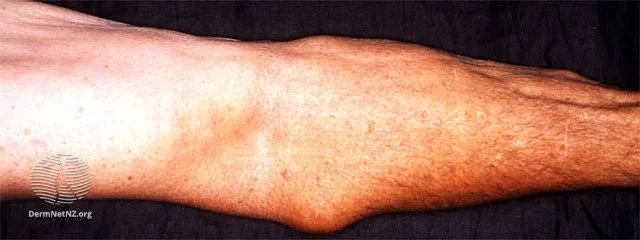
Lipomas
Lipomas manifest as soft, fatty tissue growths under the skin, as seen on the arm.
Credit: DermNet NZ
What are lipomas?
Lipomas are non-cancerous growths of fatty tissue that form soft lumps beneath the skin. These benign tumors predominantly emerge in body areas with a higher fat concentration, such as the thighs, upper arms, and back. Being encapsulated, they are well-defined and can move slightly under the skin when pressed.
What causes lipomas?
Lipomas originate mainly due to random genetic mutations in the fat cells. Certain individuals possess a genetic predisposition that makes them more susceptible to lipoma formation, and they might experience multiple occurrences. Additionally, physical trauma, like an accidental knock to the body part, can sometimes instigate the development of a lipoma.
What are the symptoms of lipomas?
In most cases, lipomas are asymptomatic, meaning they don't exhibit any symptoms. They usually present as soft, palpable lumps under the skin. While they are typically painless, they can become tender or painful, especially if they grow deep and exert pressure on neighboring nerves.
How do I treat lipomas?
Lipomas are benign and there's no established way to prevent their formation. They generally remain stable in size and don't resolve spontaneously. A clinical examination is often adequate to diagnose a lipoma. Characteristics like softness, defined borders, and mobility upon touch are indicative of a typical lipoma. If there's any deviation from this norm, such as rapid growth, pain, or unusual consistency, medical intervention may be warranted.
The primary treatment for concerning lipomas is surgical excision. During this procedure:
The area around the lipoma is numbed using an anesthetic like lidocaine.
A small incision, roughly the length of the lipoma, is made.
The lipoma is then carefully extracted through this opening.
Following removal, there's a 5-10% chance that the lipoma may recur in the same location. If it does, another excision can be performed. The extracted tissue is typically sent to a pathology lab to ensure its benign nature. Although surgical removal is effective, it might result in a scar approximately the size of the initial lipoma. For deeper or more extensive lipomas, imaging techniques such as ultrasound or MRI might be employed to gauge the full extent of the growth.
Patients can sometimes have multiple lipomas, and they can be tender to the touch.
Credit: DermNet NZ


